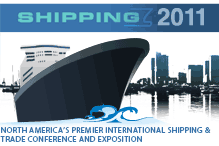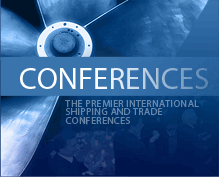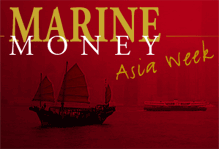
The Economy and the Markets
STAY HOPEFUL
Investor sentiment is very often unpredictable and moody, especially today when economic data continues to come in mixed and casts doubts on whether the economic stabilization will be able to materialise into a recovery. And against this uncertain backdrop, it was refreshing to listen to an optimistic voice among the crowd on where the global economy is heading. François Trahan, Senior Managing Director and Chief Investment Strategist, ISI Group started off the Wednesday’s session of Marine Money Week on a positive note by reminding the audience that even though consumer deleveraging has already begun and may well continue for the next decade, equities can rally even during such times if the government is able to offset the consumer contraction. He pointed out that the US stimulus package is still very much in its infancy stage considering the fact that the government has only spent 5% or USD 42 billion out of the USD 787 billion.
Not Just a Warm-up
Prior to the start of the festivities, Teekay Corporation held its successful shareholders meeting. The room was filled with over 100 spectators with another 200 viewing through the webcast. What was extremely interesting to hear from the Teekay delegation was the acknowledgement that they did not recognize many of the people in the room. Fresh blood!
The first session began under cloudy but dry skies an unusual event in New York these days. The room was packed with the audience hoping to glean insights from last year’s deal of the year winners as the architects of the transactions discussed their deals and how they fit in today’s marketplace. The discussion was led by Stephen Peepels of DLA Piper.
Continue Reading
The Longest Running Show on Fifth Avenue
Impresario Lawrence and his able assistant, Mike McCleery, have done it again. It is no Broadway production, but for 22 years Marine Money Week has successfully brought together shipping and capital. And the amazing thing is that every year they, in the words of the famous chef Emeril Lagasse, “kick it up a notch.” And its not only the conference, carpe diem becomes the watchword of the week as many companies plan events around this huge event. Some of the sideshows this year include Teekay’s shareholders’ meeting, Kalliopi Lemos Public Arts Installation, cocktail parties (DnB Nor, YSP, AMA, NASDAQ, Jefferies, ICON, Dahlman Rose and HSH Nordbank), the speakers’ dinner and a private dinner sponsored by FBR. And we’re sure quite a few did make our radar screen. Jim Lawrence can be proud of his baby, which has grown to become one of the most important annual events on the shipping calendar. For owners and bankers, it is the place to celebrate (even small successes), commiserate, learn, and most importantly network. There is nothing better than seeing old friends and making new ones.
Continue Reading
A Sad Note Close to Home
After Tuesday’s news of Nordea’s foreclosure of 13 of their vessels, Eastwind Maritime announced on Wednesday that it had filed a voluntary Chapter 7 petition for the liquidation of the company and its subsidiaries.
This is a very sad moment for us having known Messrs Kousi and Simmons for many years as they built up their reefer business and began what we believed was a logical diversification. In our mind, there are no two better shipping minds around. And, more importantly, they were always willing to take the time to teach and help others, of which I count myself as one of the fortunate ones. Whether the expansion was ill timed or they were simply caught in a debt trap, we are certain we have not heard the last from these gentlemen.
Dropdown Plus Liquidity
Last Thursday, after the market closed, Teekay Tankers (“TNK”) announced that it had utilized its shelf registration and filed a secondary offering of 7 million Class A common shares. The offering was led by Morgan Stanley and Citi and includes a green shoe of 1.05 million shares. Shares closed Thursday at $10.61. On Friday, the company priced the issue at $9.80, a 7.6% discount to the prior closing price. In the enclosed Guts of the Deal, we highlight the terms of the offering.
Proceeds will be used to acquire the M/T Ashkini Spirit, a 2003-built Suezmax tanker, for $57 million with the balance, approximately $9 million, used to repay a portion of its revolver. This transaction was not a simple acquisition but was designed to increase the liquidity of the company, which previously used cash to purchase two Suezmax tankers last March. Along with the acquisition of the vessel, $58 million of undrawn availability under the revolving credit facility was dropped down increasing TNK’s undrawn credit lines by $66.6 million.
Continue Reading
An Explanation
The rise in the BDI has taken everyone by complete surprise. But in reality the reason for the rise is rather simple. China binge buying iron ore against all expectations with imports rising at 27+ pct higher in 2009 than for 2008, based on the annualized results of the first 4 months of this year, shows you where the big move from the demand side has come from. This rise in iron ore imports is despite the fact that steel production in China in the first four months of 2009 has been roughly at the same levels as we had seen in 2008. An explanation for this increased iron ore imports could be from the fact that domestically produced iron ore in China is of a rather poor quality and quite expensive when compared to spot imported prices. Another explanation could be that of speculators getting into the import market to try and get hold of ‘cheap’ iron ore that would possibly be required under the Chinese Government’s USD 586 billion stimulus plan. And a third could be the impending conclusion of the iron ore contract price negotiations.
Obviously, when you binge buy and compress imports of a single commodity, carried mainly by Cape size ships, into a very short space in time, you tend to create two issues at the same time. Firstly, you tend to push up freight rates due to the time-compressed/explosive demand growth for that ship-sector. And more significantly, you create queues at loading and discharging ports which tend to reduce availability of spot ships driving prices even higher. Combine this with delayed delivery schedules of dry bulk ships during Q4 08 and Q1 09 and you have the ingredients of a perfect storm especially when you take the number of Cape size ships that have been sent to the scrap-yard during the last 6/9 months. Continue Reading
A Masterful Blend of East and West
The role of ship finance advisors is undoubtedly more pronounced today when traditional bank debt financing remains hard to come by. Shipowners are becoming more receptive towards creative financial structures so as to gain access to the pockets of liquidity available. This week in Marine Money Asia, Dimitris Belbas, Head of Ship Finance of Seafin, shares with us more about Seafin and his views on the current ship finance market.
Seafin’s Profile
Seafin was established in Singapore in April 2007 as a joint venture between the Eurofin Group, one of the biggest shipping finance advisory companies and Seven Oceans, one of the few independent ship-broking firms in Japan. With Asia’s increasing importance in the maritime industry, Seafin’s objective is to maximize the synergies between the Japanese and Asian shipping networks with the European know-how and expertise in shipping finance. Continue Reading
Half Full or Half Empty?
China has almost single handedly supported the whole dry bulk market despite the world economic gloom. While the BDI marches forward largely due to the tight Capesize tonnage supply, it remains anyone’s guess if this frantic pace of iron ore chartering will continue to last. Will China’s USD 585 billion stimulus package whet the country’s appetite for commodities when infrastructure project spending picks up steam? Or is this just pure stockpiling speculation and a bear market rally?
In the meantime, there are increasing concerns that China’s recovery may come at the expense of inflating asset bubbles, increasing economic volatility and burgeoning bad bank loans. Latest figures showed that China’s new lending doubled to RMB 664.5 billion (USD 97 billion) in May from RMB 318.5 billion a year earlier and industrial output rose by 8.9% year on year. Ma Jun, chief China economist with Deutsche Bank AG in Hong Kong described the pace of bank lending as dangerous but there are also those who beg to differ. In a recent report entitled “The World’s Largest Local Banks, The Largest in the World”, analysts at Taifook Securities believe that the concerns over asset quality deterioration appear exaggerated. The securities house says the current infusion of credit actually eases the liquidity crunch for many medium sized private enterprises, thereby providing an opportunity for highly leveraged sectors, notably property, to restructure their balance sheets. Whatever the case may be, we expect regulators to scrutinize new lending more closely to deter speculation. Continue Reading
Understanding the Capital Markets and Shipping Star Bulk Carriers – Why the Underdog?
By Kevin Oates
Wasn’t life so easy before the recent financial crisis? Dry bulk shipping companies were making money hand over fist; dividends were certain from the dividend paying companies; growth was secure from those companies looking to reinvest. Analysts piled praise on all the companies (with one or two exceptions) as targets were met and exceeded and all strategic decisions were seen as wise insights into the market. There were very few players – companies, analysts or investors – who were not bullish on shipping.
But the world has changed. And today the listed shipping companies have to get by with plaudits from analysts when they wave goodbye to deposits but slash CAPEX, negotiate the reduction of a time charter but extend the duration and get the inevitable waivers from their banks. For those of us involved in the industry it is almost hilarious to imagine that a top shipping bank (and the syndicate of which it is agent) would not grant a waiver to a shipping company with modern assets (which most of them have), good income stream (which most of them have albeit with the concern of charterer renegotiation), transparency (which all of them have, that being the nature of the public markets) and trusted management (which we hope they all have because if they have not, it is not only the banks that should be worried).
Continue Reading
d’Amico Opts Out
On Tuesday, d’Amico International Shipping announced that Glenda International Shipping, its joint venture with Glecore, terminated and rescinded a newbuilding contract related to Hull S510, a 51,000 DWT product/chemical tanker being built at SLS Shipbuilding in Tongyeong Korea. The company blamed excessive delays in deliveries. The company is asking for the refund of all advances made plus accrued interest. One down, more to come.







